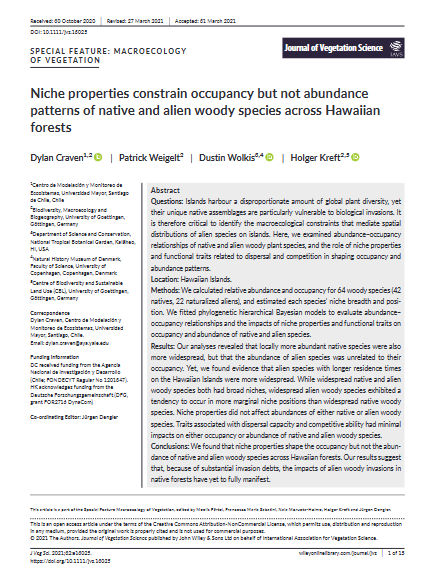Niche properties constrain occupancy but not abundance patterns of native and alien woody species across Hawaiian forests

Fecha
2021-05Autor
Craven, Dylan [Univ Mayor, Ctr Modelac & Monitoreo Ecosistemas, Chile]
Weigelt, Patrick
Wolkis, Dustin
Kreft, Holger
Ubicación geográfica
Notas
HERRAMIENTAS
Acceda a títulos restringidos
¿Cómo descargar?Resumen
Questions Islands harbour a disproportionate amount of global plant diversity, yet their unique native assemblages are particularly vulnerable to biological invasions. It is therefore critical to identify the macroecological constraints that mediate spatial distributions of alien species on islands. Here, we examined abundance-occupancy relationships of native and alien woody plant species, and the role of niche properties and functional traits related to dispersal and competition in shaping occupancy and abundance patterns. Location Hawaiian Islands. Methods We calculated relative abundance and occupancy for 64 woody species (42 natives, 22 naturalized aliens), and estimated each species' niche breadth and position. We fitted phylogenetic hierarchical Bayesian models to evaluate abundance-occupancy relationships and the impacts of niche properties and functional traits on occupancy and abundance of native and alien species. Results Our analyses revealed that locally more abundant native species were also more widespread, but that the abundance of alien species was unrelated to their occupancy. Yet, we found evidence that alien species with longer residence times on the Hawaiian Islands were more widespread. While widespread native and alien woody species both had broad niches, widespread alien woody species exhibited a tendency to occur in more marginal niche positions than widespread native woody species. Niche properties did not affect abundances of either native or alien woody species. Traits associated with dispersal capacity and competitive ability had minimal impacts on either occupancy or abundance of native and alien woody species. Conclusions We found that niche properties shape the occupancy but not the abundance of native and alien woody species across Hawaiian forests. Our results suggest that, because of substantial invasion debts, the impacts of alien woody invasions in native forests have yet to fully manifest.
URI
https://repositorio.umayor.cl/xmlui/handle/sibum/9142https://onlinelibrary-wiley-com.bibliotecadigital.umayor.cl:2443/doi/epdf/10.1111/jvs.13025
https://doi.org/10.1111/jvs.13025
Coleccion/es a la/s que pertenece:
Si usted es autor(a) de este documento y NO desea que su publicación tenga acceso público en este repositorio, por favor complete el formulario aquí.